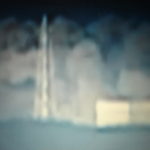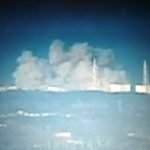
JAPAN’S NUCLEAR AUTHORITIES say they believe that three reactors at the stricken Fukushima nuclear power plant are now melting.
The country’s chief cabinet secretary, Yukio Edano, said that although staff at the nuclear facility – where two containment buildings have been destroyed by hydrogen explosions – were unable to check for certain, it was “highly likely” that the nuclear cores at reactors, 1 2 and 3 at Fukushima I nuclear station had begun to melt.Reuters had earlier reported that the cooling mixture of seawater and boron in the number 2 reactor had totally evaporated, with the reactor’s nuclear rods therefore totally exposed for a significant period of time.
The plant operator TEPCO had earlier said it couldn’t rule out the possibility of a nuclear meltdown in the reactor – and had admitted that a partial meltdown could already be underway.
TEPCO had previously said it believed a partial meltdown had occurred at the number 1 reactor, where a hydrogen explosion occurred at a containment building on Saturday, but retracted reports that a similar meltdown had occurred following another hydrogen blast today at the number 3 reactor.

From Dr. Michio Kaku:
This isn’t the type of situation that otherwise has a step-by-step emergency plan. We are witnessing a gigantic science experiment, with the Japanese people as guinea pigs. With everything seemingly have a domino effect at this point, the utility is literally making this up as they go along. Problems continue to arise at nearly every turn and is clearly making it difficult to gain traction.
News & Developments:
- Three reactors (units 1,2,3) are now involved with partial meltdowns.
- Units 1 and 3 have had their outer containment wall blown off by huge hydrogen gas explosions. (The hydrogen gas comes from a chemical interaction between water and the zirconium cladding surrounding the rods.
- The gas explodes when it is vented and interacts with oxygen.)
- All three units have had some core damage. Units 2 and 3 apparently were almost totally uncovered at some point, without any cooling water. Sea water is apparently leaking out of Unit 3, so that seawater is escaping as soon as it is flushed into the core. Even fire hoses are being used to keep sea water in the core. This also means that the reactors will become permanent pieces of junk afterwards, unfit for commercial use.
- The water level gauge that measures how much water there is in the nuclear core is broken, and hence reliable figures are hard to get.
- Radiation levels have soared. Several workers have shown full blown symptoms of radiation sickness (probably indicating that they absorbed perhaps tens of thousands of X-ray equivalents).
- Unit 3 contains MOX fuel (mixed oxide fuel) which contains plutonium, which is one of the most toxic chemicals known to science. So a possible meltdown there might spread this deadly chemical as well.
- The state of the nuclear waste units is unclear so there is always the possibility that the huge nuclear waste contained in these storage units might escape.
From The New York Times…
The more time that passes with fuel rods uncovered by water and the pressure inside the containment vessel unvented, the greater the risk that the containment vessel will crack or explode, creating a potentially catastrophic release of radioactive material into the atmosphere — an accident that would be by far the worst to confront the nuclear power industry since the explosion of the Chernobyl nuclear power plant 25 years ago.
In reactor No. 2, which is now the most damaged of the three at the Daiichi plant, at least parts of the fuel rods have been exposed for several hours, which also suggests that some of the fuel has begun to melt. If more of the fuel melts before water can be injected in the vessel, the fuel pellets could burn through the bottom of the containment vessel and radioactive material could pour out that way — often referred to as a full meltdown.
“They’re basically in a full-scale panic” among Japanese power industry managers, said a senior nuclear industry executive late Monday night. The executive is not involved in managing the response to the reactors’ difficulties but has many contacts in Japan. “They’re in total disarray, they don’t know what to do.”
From Democracy Now interview of Harvey Wasserman, Kevin Kamps, and Arnie Gunderson:
DN: Harvey, this latest news of the Japanese nuclear reactor, water levels inside almost empty, according to the power plant’s operator, Tokyo Electric Power. Then, the news agency Jiji saying a meltdown of fuel rods inside the Fukushima Daiichi complex’s No. 2 reactor could not be ruled out. Can you explain the significance of this, the exposure of the fuel rods?
HARVEY WASSERMAN: Well, it’s hugely significant, and it’s a very, very dangerous situation. I should note that the first reactor at Fukushima is identical to the Vermont Yankee plant, and which is now up for relicensing and which the people of Vermont are trying to shut. And we should also note that this kind of accident, this kind of disaster, could have occurred at four reactors in California, had the 9.0-Richter-scale earthquake hit close to Diablo Canyon at San Luis Obispo or San Onofre between L.A. and San Diego. We could very well now be watching Los Angeles or San Diego being evacuated, had this kind of thing happened in California. And, of course, the issue is the same in Vermont. There are 23 reactors in the United States that are identical or close to identical to the first Fukushima reactor.
Now, this exposure of fuel is about as bad as it gets. It means that these fuel rods, superheated fuel rods, could melt if they are exposed to water, which they’re trying to pour water in there. It could create radioactive steam, conceivably blow off the containment and result in another Chernobyl and a horrific, horrendous release of radiation that could, and in fact would, come to the United States within a week or so, as the Chernobyl radiation came to California within 10 days. This is about as bad as it gets. And we are not 100 percent sure we’re getting fully accurate information. We only know that the worst case scenario is very much a possibility. There are 10 reactors at the Fukushima site—two separate sites, one with six reactors and one with four. And the fact that a U.S. aircraft carrier has detected significant radiation 60 miles away is very much a dangerous sign. It means that radiation releases are ongoing and probably will only get worse.
KEVIN KAMPS: Yes, Amy, as your Japanese guest said, the cores of at least three reactors now at Fukushima Daiichi are uncovered from water, and so, therefore, a meltdown is likely underway at three reactors. Something that has not gotten much mention yet are the pools of high-level radioactive waste at these very same reactors, which also need cooling. They need electricity to cool, to circulate the water with circulation pumps. And each of the—well, two of these three reactors have suffered explosions, as your guests may have seen online in videos. And the pools that hold the high-level radioactive waste are located above, just slightly above, and to the right of the reactors. So, our hope and our prayer at this point is that not only the reactor itself, the containment around the reactor, but also the pools, which contain massive amounts of radioactivity, have somehow remained intact. That’s what the officials are saying. As Harvey said, we don’t know whether to believe them or not.
In the pools, you have a lot of radioactive waste, which contains a lot of hazardous radioactivity. And now, because those explosions took place at two of those reactors, that is open to the sky at this point. There is no roof or walls over the pools. And the hope is—but we have indications that at Fukushima Daiichi unit 1, that the pool is experiencing difficulty in cooling the waste, because electricity has been lost. They lost the electricity grid with the earthquake. They lost the emergency diesel generators with the tsunami. The backup batteries only had a life of four to eight hours. That’s long passed.
ARNIE GUNDERSEN: Yeah. When the reactor shuts down, what that means is that the uranium atom doesn’t split anymore. But these pieces that are left behind are still radioactive, and they generate about five percent of the reactor’s heat. And you’ve got to dump that heat for as long as a year or two or three. So, what’s happened is that there has been no way to remove that heat, and that’s caused the nuclear fuel to hit 2,200 degrees. At that point, the nuclear fuel begins to suck up the oxygen atoms in water. Water is H2O. And that gives off hydrogen gas. So the hydrogen explosions that we’re seeing at two of these reactors are an indication that the water is being stripped of its oxygen and creating hydrogen. So, the cores are uncovered, and when the cores are uncovered, unfortunately, that’s what happens. Now, the problem in the long haul is that now that these cores have been uncovered and there’s no way to cool them, they will have to continuously vent these containments. And as the Times said, you’re not going to get back into these villages in the next week or two. It could easily be months, if not years, before these villages can be inhabited again.
AMY GOODMAN: The effects of radiation on humans, Arnie Gundersen?
ARNIE GUNDERSEN: It’s too early to tell, but as your previous speaker said, you know, they tested—they talk about 160 people that have been contaminated. That’s all they’ve tested. Basically, everything they’re testing is coming up contaminated in that inner couple of miles around the plant. You’ve got radiation being detected 60 miles to the north in a Navy helicopter, a hundred miles to the east on a Navy aircraft carrier. So, it’s not clear to me that that cloud is not looping around and affecting Japan. And, of course, I think the worst case, as Mr. Kamps suggested, is that the fuel pools on these reactors, that sit very high, and they’re designed just like the Vermont Yankee one, if the fuel pools are not cooled, they will melt down, in which case we’re going to have Chernobyl on steroids.
- The utility states that the situation is, at present, stable. This might be true, but its the stability of hanging on a cliff by your fingernails.












Pingback: Disaster Roulette: Earthquakes and Nukes at San Onofre | wilderutopia.com